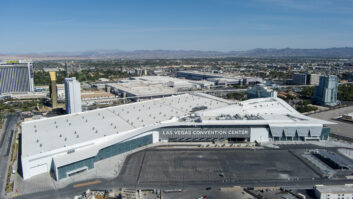DETROIT Ed Buterbaugh would have made most anyone’s list of the “most respected” engineers. That probably never really mattered to Buterbaugh.
Friends say that whether he was building new radio studios or engineering a University of Michigan football game, Buterbaugh was comfortable with his place within the profession.
(click thumbnail)Buterbaugh at WJR, circa 2000.
Buterbaugh, a longtime fixture in Detroit radio and respected broadcast engineer, passed away from bladder cancer in September. He was 65.
He had engineered three of the top AM radio stations in North America. He worked for a stint at WABC(AM) in New York, followed by CKLW(AM) in Windsor, Ontario, a station that dominated Detroit’s radio ratings for many years in the 1970s. He finished his career at Citadel’s WJR(AM) in Detroit and retired in late 2004.
Many engineers consider Buterbaugh a driving force in AM audio quality. He was relentless in his pursuit of AM fidelity and was a respected talent not only within the discipline of broadcast engineering but by broadcasters in general, friends and colleagues say.
All about the sound
“He was serious about making his stations sound better. And not just better, but the best,” said Alan Buterbaugh, Ed’s son and senior vice president for business development for Wireless Ronin Technologies.
“He enjoyed nothing more than packing a cooler of beer and heading to his house on the beach on Lake Erie and listening to all the stations on the dial to see how his compared.”
Buterbaugh’s commitment to details knew no limit, said Michael Fezzey, president/general manager of WJR.
“Ed did everything with excellence in mind. He was a fun-loving, hard-driving broadcast engineer who battled for the resources to improve the sound of his stations.”
Chris Arnaut, IT manager for WDIV(TV), Detroit, was hired by Buterbaugh in 1996 as a bench tech and remote engineer.
“Ed had a passion for audio supremacy over everyone else. Not for his own ego, but rather for his own deeply rooted love of audio.”
Arnaut said his Buterbaugh’s penchant for perfection led to audio standards that often brought stares from contemporaries.
“For example, for the national anthem at University of Michigan games, ABC-TV and ESPN were satisfied using a single Shure M58 microphone. Not Ed. We used a stereo SASS mic on digital delays so the music was synchronized with the talent’s microphones in the booth. All angles were always considered,” Arnaut said.
Then there was the time Buterbaugh coordinated a live remote with Cadillac for WJR. The remote consisted of morning talent Paul W. Smith riding through town broadcasting from the back seat of a new car with an engineering van in tow containing the necessary wireless receiver and IFB, Arnaut said.
“The topper was Ed getting on the phone with the Bose radio company to complain about the sub-standard AM tuner section of the Bose Acoustic Wave desktop receiver.
(click thumbnail)Buterbaugh appeared in a brochure for Pacific Recorders about a rebuild at WJR around 1987.
“He spent a half-hour on the phone with Dr. (Amar) Bose himself recommending solutions that could be implemented in the Wave Radio,” Arnaut said.
Determination
It was that doggedness that fellow broadcast engineers admired, said Tony Butler, assistant CE at WJR.
“He never settled for second best. His detail in pursuit of quality was very evident,” Butler said. “One of the most obvious daily reminders of Ed’s legacy is the quality sound of WJR.”
Buterbaugh was a strong believer in public safety and warning and was involved with EAS affairs, said Larry Estlack, director of technology for the Michigan Association of Broadcasters.
Don Backus, vice president of sales and marketing for ENCO Systems, said, “Keeping WJR on the air at all times was the most important thing to Ed. When ENCO installed digital automaton systems for (WJR) in 2000, one of the first things he told me was ‘WJR cannot go off the air,’ and he meant it,” Backus said.
That commitment was tested during the blackout of 2003 when widespread power outages struck parts of the eastern third of the United States, Backus recalled.
“I remember how WJR stayed on the air through it all while some other Detroit stations struggled to do so,” Backus said.
Buterbaugh’s radio experience dated to his teens.
He was raised in the community of Indiana in the state of Pennsylvania, where he began work for WDAD(AM) as a 14-year-old, engineering remote broadcasts and running audio for Sunday morning church services, said Pam Buterbaugh, Ed’s wife of more than 42 years.
“I recall him telling me after we first met when he was in high school that he would work for WABC and CKLW someday. We could listen to both stations where we grew up and he always said they sounded the best,” she said.
Buterbaugh attended Grantham College of Engineering near Washington for radio engineering and later went to work for WEAM(AM) in Arlington, Va. He joined WABC(AM) in New York in the late 1960s to work as a station engineer with DJ Cousin Brucie in the evenings.
“(Ed) was thrilled to be in a major market,” his wife said.
It was back to WEAM in the early 1970s for a short time before he joined CKLW(AM) in Windsor, Ontario, in 1972.
‘Big booming sound’
Buterbaugh is credited by colleagues with constructing the on-air sound of the station, known as “the Big 8 CKLW,” with its cast of boss jocks and high-energy newscasts.
“He was the mastermind behind the big booming sound of the station during its reign over Detroit radio in the mid-1970s,” said Art Voulo, Jr., radio historian and journalist. “The station sound was bigger and better than anything else on AM.”
CKLW was a broadcast juggernaut across parts of the upper Midwest, those familiar with Detroit radio history said.
“Those were great times and Ed loved every minute of it. He was very busy. But (CKLW staff) did a lot of partying and had fun, too, during that time,” said Pam Buterbaugh.
Ed Buterbaugh was chief engineer and vice president at CKLW before leaving in 1986 for Detroit’s WJR. He spent 20 years at WJR perfecting the sound of the “Great Voice of the Great Lakes,” colleagues said.
“Ed insisted the fidelity [be] maximized to its fullest potential. He processed AM like it was FM,” said WDIV’s Arnaut. This as true even on remotes. When other AM stations were using POTS codecs, Arnaut said, “WJR was using a three-line Gentner frequency extender, which was also fed through a Dolby SR noise reduction unit in the field.”
Arnout described the extensive audio chain Buterbaugh designed at WJR as “maximized to ensure no fidelity was sacrificed” so the listening experience would be enjoyable.
“Processing at the studio included an Aphex Compeller, with CRL pre-processing, Dolby SR encoders and an Optimod stereo generator. The composite output from there was fed through the Dolby decoders, a phase chaser and another compeller and finally an Omnia that fed the transmitter,” Arnout said.
Buterbaugh built new studios for WJR in the Fisher Building in downtown Detroit in the late 1980s and oversaw periodic upgrades for WJR and its FM sister stations.
“He was amazingly talented and truly WJR is his broadcast legacy,” said Fezzey.
Buterbaugh won several awards from the Michigan Association of Broadcasters along with other industry honors and presented many papers on AM radio at radio engineering conferences.
Buterbaugh is survived by his wife, three children and nine grandchildren.


His Colleagues Look Back
(click thumbnail)Buterbaugh, standing right, at a Disney remote in Anaheim, Calif., about 10 years ago.Orban’s Greg Ogonowski was inspired by Ed Buterbaugh and collected these comments about him:
Ed was one of my biggest technical inspirations for developing audio processing systems.
Ed made CKLW, Windsor, Ontario one of the finest sounding radio stations in North America. After leaving Detroit fresh out of school, I soon realized how many ‘broken’ radio stations there were in the world.
It was CKLW and Ed Buterbaugh who helped shape and mold the sound of the Gregg Laboratories Audio Processing Systems. Knowing his excellence in audio, Ed paid me the ultimate compliments when he chose our processor for CKLW(AM) in stereo, and then again for CKLW(FM) “The Fox.”
Ed and his wife Pam always made me feel like family, never allowing me to stay at a hotel. When visiting, I always stayed with the entire family, including the dogs, at Camp Buterbaugh, overlooking majestic Lake Erie with that awesome view.
And yes, there were those infamous dingy trips on Lake Erie to not only sample the radio signals, but also enjoy several adult beverages in the process. Visiting CKLW was always an adventure and a chance to party.
The staff always welcomed me. It seemed like “the station that I worked at, that I never really worked at.” Ed and I certainly had one thing in common to make all this happen: “We never took no for an answer.” He is a mentor who will be truly missed.

— Greg Ogonowski
Vice President of Product Development
Orban
By the early 1970s, having extensive rebuild experience with XELO(AM) — which back then was in Juarez, Mexico — and KOMA(FM), Oklahoma City, Okla., I soon realized that most of the big recognized engineering names of the day where not up for sharing what they knew with the younger up-and-coming crop of broadcast engineers. It was obvious that at the end of the day, for the most part, you where on your own to “sink or swim.”
It was during this time in my life I had the chance to meet Ed Buterbaugh and hear CKLW for the first time. From that time on I have been blessed to have a personal friendship and professional relationship that has spanned over 36 years.
Never once during this relationship did Ed ever tire of my relentless questions about how he had envisioned and executed his numerous engineering feats at CKLW and elsewhere. I think that having grown up as an only child, with both his parents being teachers, made him a natural for being a born mentor.
All of us who took due note from Ed recall that he looked forward to spirited debate on whatever questions were presented, but you knew that you were expected to make clear to him that you had indeed full grasp of what he had just explained to you. I also was always welcomed at Camp Buterbaugh over the years and felt it a great privilege to be received as family in his inner sanctum.
To this day, there very seldom is an engineering project I undertake, that I first do not ask myself as to how Ed would approach the same given task. It would not have surprised me that Ed would have eventually found time to teach engineering classes if he had not been taken from us so quickly after starting his retirement.
There has never been a finer AM medium-wave signal to cut through the ether over North America than CKLW during the years Ed has his hand firmly on the throttle. History will be written that we were blessed to witness one of the handful of engineers who truly knew how to “make the box speak.”
— Bruce Earle
Senior Technical Advisor
I first met Ed in Washington in 1970. Ed was at WEAM(AM) and I was at WRC(AM)/NBC, both of us young and ready to innovate and fix all the problems inherent in AM radio. We had many technical discussions, and many beers were consumed during these conversations.
Later in 1977, I was employed at a Washington broadcast consulting firm, Carl T. Jones Corp. Ed was now at the Big 8, CKLW and was going to rebuild the antenna system.
With much calculating in the firm we built the phasor and antenna tuning units and tuned it up. The wide-bandwidth antenna system coupled with Ed’s savvy audio processing brought about a new era in rock and roll radio, so fitting for the third-highest billing station in North America.
A small radio transmitter even enabled CKLW to broadcast inside the Detroit-Windsor tunnel. You just never lost it!
In 1984 Ed went on to go across the Detroit River to Capital Cities WJR, “The Great Voice of the Great Lakes.” Our firm again was employed to build tuning units for the main and auxiliary antennas. Again the audio was like no other; as close to FM as could be had.
His expertise extended to the personal mixing of the University of Michigan football broadcasts. Using seven microphones around the stadium, parabolic mics, and much attention paid to the U-M band, the football game became a wonderful experience to enjoy. The listener was truly in the “big house.”
Paying attention to the important details was the norm. It always was great to be challenged by Ed. Good enough was never acceptable, but rather as perfect as possible. Ed’s life’s work was the epitome of that philosophy.
— Harv Rees,
Broadcast Technical Consultant












